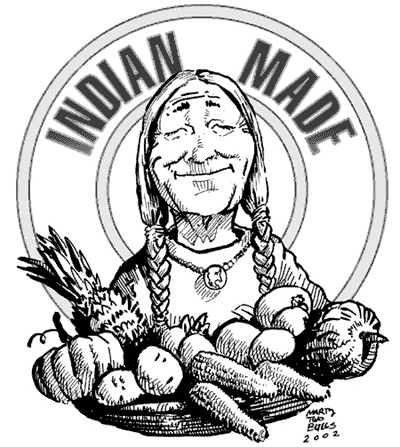"Legend has it...": More Natives in Advertising
She saw this sign in Harvard Medical School's cafeteria:

There are only three fruits native to North America: blueberries, cranberries, and Concord grapes. Legend has it that Native Americans gave blueberries to the new settlers, helping them make it through their first winter.
1) It refers to generic "Native Americans" rather than specific tribes such as the Wampanoag.
2) It makes the Natives players in the settlers' story rather than stars of their own story.
I could add that the sign obscures what happened by using the ultra-positive word "settlers." Try it with "colonists," "foreigners," "Europeans," "interlopers," or "invaders" and see how it reads. Not quite as benign, I'd say.
Only three fruits?
But the real problem is the claim that Natives had only three fruits. I never heard this claim before, and it's ridiculous. Anyone who knows anything about Natives knows it to be false.
In fact, apparently this myth is so common that people have discussed it on Snopes.com:
Fruits of North American origin
By including only "culinary" fruits--fruits we think of as fruits rather than vegetables--the list excludes tomatoes, pumpkins, and other varieties of squash. So add two of the biggest fruits in the world to the list of Native products.
Someone on Facebook responded to the "three fruit" claim:
How has this "legend" lasted when it's demonstrably false? I'd say it's a corollary of the uncivilized Indian meme. Indians supposedly didn't invent the wheel, writing, or metalworking. They were Stone-Age savages, ignorant of the arts and sciences. They were so primitive they had only three fruits! They were able to gather roots and berries like other forest animals, but they knew nothing about real food. You know, the kind that civilized people grew on farms in orchards and vineyards.
(For the record, some Indians did invent the wheel, writing, and metalworking.)
Adrienne's conclusion:
For the actual story abut Native food, see Native Foods Changed the World.


4 comments:
Only three fruits? How did plants reproduce?
Nothing surprises me about America's so-called institutions of higher learning.
Any country that celebrates a man condemned by his own crown for "discovering" a country that gets named by another traveler (Amerigo Vespucci) who's travelings have always been debated by scholars themselves.
In America's dim-witted, half-truthed existence of continual propaganda and delusional history, should America, with respects to Columbus Day, be named Columbia?
Isn't the tomato native to the America's?
And the entire group of chiles. And pineapple. And some variety of strawberry. And of course the chokecherry.
"Three fruits" refers to three species of fruit, not three pieces of fruit, Anonymous.
I mentioned the tomato, Chief Diet Coke.
Post a Comment